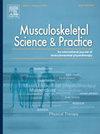教育对膝关节骨关节炎患者急性运动期间和运动后疼痛的影响:一项随机对照试验
IF 2.2
3区 医学
Q1 REHABILITATION
引用次数: 0
摘要
背景:对无疼痛个体进行运动诱导痛觉减退(EIH)的明确教育,可减少单次运动后的实验性疼痛。然而,对慢性疼痛患者的影响尚不清楚。本研究旨在确定EIH教育对膝关节骨关节炎(OA)患者运动期间和运动后疼痛的影响。方法所有手术均采用网上操作。参与者被随机分配接受15分钟的明确EIH教育或15分钟关于膝关节OA的普通教育。然后,参与者完成了一份关于他们对运动和疼痛的看法的调查问卷,随后进行了一系列基于家庭的下肢阻力训练。在运动前、运动中和运动后立即评估疼痛强度(0-10)。结果40名参与者完成了研究(67.3±10.8岁,73%为女性)。参与者只是在一定程度上同意在一次运动后疼痛可以减轻,并且教育改变了他们对运动和疼痛的看法,但这些信念在两组之间没有显著差异(分别为p = 0.053和p = 0.104)。运动期间和运动后两组疼痛相似(调整后平均差异[95% CI]) (0.51 [-0.72 ~ 1.74], p = 0.410),运动后两组疼痛相似(- 0.75 [-1.62 ~ 1.11],p = 0.087)。与基线相比,运动期间疼痛(平均差异[95% CI])(- 1.01[-1.66至- 0.36],p = 0.003)和运动后疼痛(- 0.96[-1.5至- 0.42],p <;0.001)。结论单次运动可减轻膝关节OA患者的疼痛,但运动前EIH教育对疼痛无影响。需要进一步的研究来了解EIH是否以及如何在膝关节OA患者中进行调节。本文章由计算机程序翻译,如有差异,请以英文原文为准。
The influence of education on pain during and following acute exercise in people with knee osteoarthritis: A randomised controlled trial
Background
Explicit education about exercise-induced hypoalgesia (EIH) reduces experimental pain after a single exercise session in pain-free individuals. However, the effect in people with chronic pain is unclear. This study aimed to determine the effect of EIH education on pain during and following exercise in people with knee osteoarthritis (OA).
Methods
All procedures were administered online. Participants were randomised to receive 15-min of explicit EIH education or 15-min of general education about knee OA. Participants then completed a questionnaire on their beliefs about exercise and pain, followed by a bout of home-based lower limb resistance exercise. Pain intensity (0–10) was assessed before, during and immediately after exercise.
Results
40 participants completed the study (67.3 ± 10.8 years old, 73 % female). Participants only somewhat agreed pain could be reduced following a single session of exercise and that the education changed what they thought about exercise and pain, but these beliefs were not significantly different between groups (p = 0.053 and p = 0.104, respectively). Pain was similar between groups (adjusted mean difference [95 % CI]) during exercise (0.51 [-0.72 to 1.74], p = 0.410) and following exercise (−0.75 [-1.62 to 1.11], p = 0.087. Compared to baseline, pain (mean difference [95 % CI]) was lower during exercise (−1.01 [-1.66 to −0.36], p = 0.003) and following exercise (−0.96 [-1.5 to −0.42], p < 0.001).
Conclusion
A single exercise session reduces pain in people with knee OA, but this was not influenced by pre-exercise education about EIH. Further research is needed to understand if and how EIH can be modulated in people with knee OA.
求助全文
通过发布文献求助,成功后即可免费获取论文全文。
去求助
来源期刊

Musculoskeletal Science and Practice
Health Professions-Physical Therapy, Sports Therapy and Rehabilitation
CiteScore
4.10
自引率
8.70%
发文量
152
审稿时长
48 days
期刊介绍:
Musculoskeletal Science & Practice, international journal of musculoskeletal physiotherapy, is a peer-reviewed international journal (previously Manual Therapy), publishing high quality original research, review and Masterclass articles that contribute to improving the clinical understanding of appropriate care processes for musculoskeletal disorders. The journal publishes articles that influence or add to the body of evidence on diagnostic and therapeutic processes, patient centered care, guidelines for musculoskeletal therapeutics and theoretical models that support developments in assessment, diagnosis, clinical reasoning and interventions.
 求助内容:
求助内容: 应助结果提醒方式:
应助结果提醒方式:


